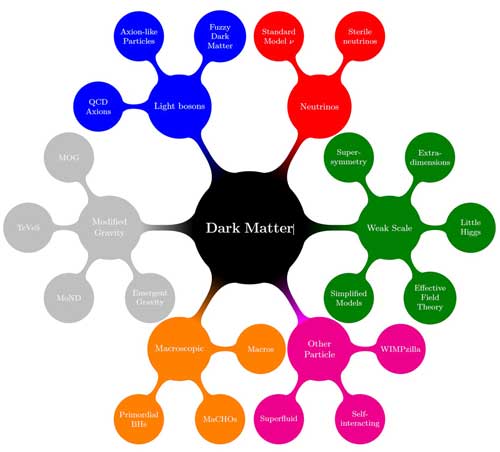| Oct 04, 2018 |
A new era in the quest for dark matter
|
|
(Nanowerk News) Since the 1970s, astronomers and physicists have been gathering evidence for the presence in the universe of dark matter: a mysterious substance that manifests itself through its gravitational pull. However, despite much effort, none of the new particles proposed to explain dark matter have been discovered.
|
|
In a review that was published in Nature ("A new era in the search for dark matter") this week, physicists Gianfranco Bertone (UvA) and Tim Tait (UvA and UC Irvine) argue that the time has come to broaden and diversify the experimental effort, and to incorporate astronomical surveys and gravitational wave observations in the quest for the nature of dark matter.
|
 |
| A map of different explanations for the dark matter phenomenon that are currently being investigated. (Image: G. Bertone and T. Tait) (click on image to enlarge)
|
|
Over the past three decades, the search for dark matter has focused mostly on a class of particle candidates known as weakly interacting massive particles (or WIMPs). WIMPs appeared for a long time as a perfect dark matter candidate as they would be produced in the right amount in the early universe to explain dark matter, while at the same time they might alleviate some of the most fundamental problems in the physics of elementary particles, such as the large discrepancy between the energy scale of weak interactions and that of gravitational interactions.
|
No stone unturned
|
|
While such a natural solution sounds like a very good idea, none of the many experimental strategies performed to search for WIMPs has found convincing evidence for their existence.
|
|
In their paper, Bertone and Tait argue that it is therefore time to enter a new era in the quest for dark matter – an era in which physicists broaden and diversify the experimental effort, leaving as they say “no stone left unturned”.
|
|
What makes the current time ripe for such a widened search is that several search methods for such a wider search already exist or are in the process of being completed.
|
|
Bertone and Tait in particular point towards astronomical surveys, where tiny effects in the shapes of galaxies, of the dark matter halos around them, and of the gravitationally bent light coming around them, can be observed to learn more about the potential nature of dark matter.
|
|
In addition, they mention the new method of observing gravitational waves, successfully carried out for the first time in 2016, as a very useful tool to study black holes – either as dark matter candidates themselves, or as objects with a distribution of other dark matter candidates around them.
|
|
Combining these modern methods with traditional searches in particle accelerators should give the search for dark matter a major boost in the near future.
|

